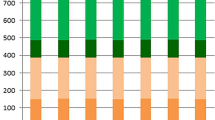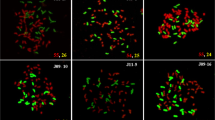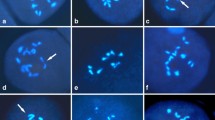Abstract
New tri-species hybrids (GOS) in the genus Pennisetum involving the cultivated species pearl millet (P. glaucum L.) and two wild species, viz. P. squamulatum Fresen and P. orientale L. C. Rich, are reported. Six hybrid plants were recovered after crossing a backcross hybrid (2n = 3x = 23, GGO) between P. glaucum (2n = 2x = 14, GG) and P. orientale (2n = 2x = 18, OO) with F1s (2n = 6x = 42, GGSSSS) between P. glaucum (2n = 4x = 28, GGGG) and P. squamulatum (2n = 8x = 56, SSSSSSSS). The hybrids were perennial, morphologically intermediate to their parents, and represented characters from the three contributing species. The hybrids contained 2n = 44 chromosomes (GGGSSO) representing 21, 14 and nine chromosomes from P. glaucum, P. squamulatum and P. orientale, respectively. Meiotic and flow-cytometric analysis suggested origin of these hybrids from unreduced female and reduced male gametes. Average chromosome configuration (8.42I + 14.32II + 1.62III + 0.52IV) at Meiosis showed limited inter-genomic pairing indicating absence of significant homology between the three genomes. The hybrids were male sterile (except one) and highly aposporous. P. orientale was identified to induce apospory in hybrid background with P. glaucum at diploid and above levels, though it was quantitatively affected by genomic doses from sexual parent. A case of inducible and recurrent apospory is presented whereby a transition from Polygonum-type sexual embryo-sacs to Panicum-type aposporous embryo-sacs was observed in diploid interspecific hybrids. Results supported independent origin and partitioning of the three apomixis-components (apomeiosis, parthenogenesis, and functional endosperm development), reported for the first time in Pennisetum. Potential utilization of GOS hybrids in understanding genome interactions involved in complex traits, such as perenniality and apomixis, is discussed.







Similar content being viewed by others
References
Akiyama Y, Goel S, Chen Z, Hanna WW, Ozias-Akins P (2006) Pennisetum squamulatum: is the predominant cytotype hexaploid or octaploid? J Hered 97:521–524
Akiyama Y, Yamada-Akiyama H, Yamanouchi H, Takahara M, Ebina M, Takamizo T, Sugita S, Nakagawa H (2008) Estimation of genome size and physical mapping of ribosomal DNA in diploid and tetraploid guineagrass (Panicum maximum Jacq.). Grassland Sci 54:89–97
Albertini E, Porceddu A, Ferranti F, Reale L, Barcaccia G, Romano B, Falcinelli M (2001) Apospory and parthenogenesis may be uncoupled in Poa pratensis, a cytological investigation. Sex Plant Reprod 14:213–217
Arumuganathan K, Earle ED (1991) Estimation of nuclear DNA content of plants by flow cytometry. Plant Mol Biol Rep 9:229–241
Bicknell RA, Koltunow AM (2004) Understanding apomixis: recent advances and remaining conundrums. Plant Cell 16:S228–S245
Bradley JE, Carman JG, Jamison MS, Naumova TN (2007) Heterochronic features of the female germline among several sexual diploid Tripsacum L. (Andropogoneae, Poaceae). Sex Plant Reprod 20:9–17
Burton GW (1944) Hybrids between napiergrass and cattail millet. J Hered 35:227–232
Calzada J-PV, Crane CF, Stelly DM (1996) Apomixis: the asexual revolution. Science 274:1322–1323
Carman JG (1997) Asynchronous expression of duplicate genes in angiosperms may cause apomixis, bispory, tetraspory, and polyembryony. Biol J Linn Soc 61:51–94
Carputo D, Monti L, Werner JE, Frusciante L (1999) Use and usefulness of endosperm balance number. Theor Appl Genet 98:478–484
Carputo D, Frusciante L, Peloquin SJ (2003) The role of 2n gametes and endosperm balance number in the origin and evolution of polyploids in the tuber-bearing Solanums. Genetics 163:287–294
Cervigni GD, Paniego N, Pessino S, Selva JP, Díaz M, Spangenberg G, Echenique V (2008) Gene expression in diplosporous and sexual Eragrostis curvula genotypes with differing ploidy levels. Plant Mol Biol 67:11–23
Chaix G, Marchais L (1996) Diversity of Pennicillarian millets (Pennisetum glaucum and P. purpureum) as for the compatibility between their gynoecia and pollens from some other Poacea. Euphytica 88:97–106
Chatterji AK, Timothy DH (1969) Apomixis and tetraploidy in Pennisetum orientale Rich. Crop Sci 9:796–799
Conner JA, Goel S, Gunawan G, Cordonnier-Pratt M, Ed Johnson V, Liang C, Wang H, Pratt LH, Mullet JE, DeBarry J, Yang L, Bennetzen JL, Klein PE, Ozias-Akins P (2008) Sequence analysis of bacterial artificial chromosome clones from the apospory-specific genomic region of Pennisetum and Cenchrus. Plant Physiol 147:1396–1411
Cox TS, Bender M, Picone C, Van Tassel DL, Holland JB, Brummer EC, Zoeller E, Paterson AH, Jackson W (2002) Breeding perennial grain: warm season grasses. Cri Rev Plant Sci 21:59–91
Dolezel J, Bartos J (2005) Plant DNA flow cytometry and estimation of nuclear genome size. Ann Bot 95:99–110
Dujardin M, Hanna WW (1983a) Meiotic and reproductive behaviour of facultative apomictic BC1 offspring derived from Pennisetum americanum–P. orientale interspecific hybrids. Crop Sci 23:156–170
Dujardin M, Hanna WW (1983b) Apomictic and sexual pearl millet × Pennisetum squamulatum hybrids. J Hered 74:277–279
Dujardin M, Hanna WW (1984a) Inducing male fertility in crosses between pearl millet and Pennisetum orientale Rich. Crop Sci 27:65–68
Dujardin M, Hanna WW (1984b) Pseudogamous parthenogenesis and fertilization of a pearl millet × Pennisetum orientale derivative. J Hered 75:503–504
Dujardin M, Hanna WW (1985) Cytology and reproduction of reciprocal backcrosses between pearl millet and sexual and apomictic hybrids of pearl millet × Pennisetum squamulatum. Crop Sci 25:59–62
Dujardin M, Hanna WW (1987) Inducing male fertility in crosses between pearl millet and Pennisetum orientale Rich. Crop Sci 27:65–68
Dujardin M, Hanna WW (1989) Crossability of pearl millet with wild Pennisetum species. Crop Sci 29:77–80
Galitski T, Saldanha AJ, Styles CA, Lander ES, Fink GR (1999) Ploidy regulation of gene expression. Science 285:251–254
Gildenhuys P, Brix K (1958) Cytological abnormalities in Pennisetum dubium. Heredity 12:441–452
Goel S, Chen Z, Conner JA, Akiyama Y, Hanna WW, Ozias-Akins P (2003) Delineation by fluorescence in situ hybridization of a single hemizygous chromosomal region associated with aposporous embryo sac formation in Pennisetum squamulatum and Cenchrus ciliaris. Genetics 163:1069–1082
Hanna WW (1979) Interspecific hybrids between pearl millet and fountain grass. J Hered 70:425–427
Hanna WW (1986) Utilization of wild relatives of pearl millet. In Proceedings of international pearl millet workshop, 7–11 April 1986, ICRISAT, Patancheru, India, pp 33–42
Hanna WW, Dujardin M (1982) Apomictic interspecific hybrids between pearl millet and Pennisetum orientale L. C. Rich. Crop Sci 22:857–859
Hanna WW, Dujardin M (1986) Cytogenetics of Pennisetum schweinfurthii Pilger and its hybrids with pearl millet. Crop Sci 26:449–453
Harlan JR, de Wet JMJ (1971) Toward a rational classification of cultivated plants. Taxon 20:509–517
Harlan JR, de Wet JMJ (1975) On ‘O’ Winge and a prayer: the origins of polyploidy. Bot Rev 41:361–390
Hu FY, Tao DY, Sacks E, Fu BY, Li P, Xu J, Yang Y, McNally K, Khush GS, Paterson AH, Li ZK (2003) Convergent evolution of perenniality in rice and sorghum. Proc Natl Acad Sci USA 100:4050–4054
Jauhar PP (1981) Cytogenetics and breeding of pearl millet and related species. Progress and topics in cytogenetics. Alan R. Liss, Inc, New York, USA
Kantama L, Sharbel TF, Schranz ME, Mitchell-Olds T, de Vries S, de Jong H (2007) Diploid apomicts of the Boechera holboellii complex display large-scale chromosome substitutions and aberrant chromosomes. Proc Natl Acad Sci USA 104:14026–14031
Kaushal P, Sidhu JS (2000) Pre-fertilization incompatibility barriers to interspecific hybridizations in Pennisetum species. J Agric Sci 134:199–206
Kaushal P, Malaviya DR, Roy AK (2004) Prospects for breeding apomictic rice: a reassessment. Curr Sci 87:292–296
Kaushal P, Roy AK, Khare A, Malaviya DR, Zadoo SN, Choubey RN (2007) Crossability and characterization of interspecific hybrids between sexual Pennisetum glaucum (pearl millet) and a new cytotype (2n = 56) of apomictic P. squamulatum. Cytologia 72:111–118
Kaushal P, Khare A, Zadoo SN, Roy AK, Malaviya DR, Agrawal A, Siddiqui SA, Choubey RN (2008a) Sequential reduction of Pennisetum squamulatum genome complement in P. glaucum (2n = 28) × P. squamulatum (2n = 56) hybrids and their progenies revealed its octaploid status. Cytologia 73:151–158
Kaushal P, Malaviya DR, Roy AK, Pathak S, Agrawal A, Khare A, Siddiqui SA (2008b) Reproductive pathways of seed development in apomictic guinea grass (Panicum maximum Jacq.) reveal uncoupling of apomixis components. Euphytica 164:81–92
Kaushal P, Agrawal A, Malaviya DR, Siddiqui SA, Roy AK (2009) Ploidy manipulation in guinea grass (Panicum maximum Jacq., Poaceae) utilizing a hybridization-supplemented apomixis-components partitioning approach (HAPA). Plant Breed 128:295–303
Khare A (2007) Cytogenetical studies on alien introgressions in pearl millet (Pennisetum glaucum L.). Ph.D. thesis, Bundelkhand University, Jhansi, India
Leblanc O, Grimanelli D, Hernandez-Rodriguez M, Galindo PA, Soriano-Martinez AM, Perotti E (2009) Seed development and inheritance studies in apomictic maize–Tripsacum hybrids reveal barriers for the transfer of apomixis into sexual crops. Int J Dev Biol 53:585–596
Li HW, Yang KK, Ho HC (1964) Cytogenetical studies of Oryza sativa and its related species. VII. Non-synchronization of mitosis and cytokinesis in relation to the formation of diploid gametes in hybrids of Oryza sativa and O. officinalis. Bot Bull Acad Sin 5:142–145
Marchais L, Tostain S (1997) Analysis of reproductive isolation between pearl millet (Pennisetum glaucum (L.) R. Br.) and P. ramosum, P. schweinfurthii, P. squamulatum, and Cenchrus ciliaris. Euphytica 93:97–105
Martel E, Poncet V, Lamy F, Siljak-Yakovlev S, Lejeune B, Sarr A (2004) Chromosome evolution of Pennisetum species (Poaceae): implications of ITS phylogeny. Plant Syst Evol 249:139–149
Martinez CP, Arumuganathan K, Kikuchi H, Earle ED (1994) Nuclear DNA content of ten rice species as determined by flow cytometry. Jpn J Genet 69:513–523
Matzk F (1982) Vorstellungen uber potentielle wege zur Apomixis bei Getreide. Arch Zuechtungsforsch 30:167–172
Matzk F, Prodanovic S, Baumlein H, Schubert I (2005) The inheritance of apomixis in Poa pratensis confirms a five locus model with differences in gene expressivity and penetrance. Plant Cell 17:13–24
Nagesh CH, Subrahmanyam NC (1996) Interspecific hybridization of Pennisetum glaucum (L.) R. Br. with wild relatives. J Plant Biochem Biotech 5:1–5
Narayan NK (1951) Cytogenetic studies of apomixis in Pennisetum. Ph.D. dissertation, University of California, Berkeley
Nassar NMA (2006) Chromosome doubling induces apomixis in a cassava × Manihot anomala hybrid. Hereditas 143:246–248
Naumova TN, Hayward MD, Wagenvoort M (1999) Apomixis and sexuality in diploid and tetraploid accessions of Brachiaria decumbens. Sex Plant Reprod 12:43–52
Nogler GA (1984a) Gametophytic apomixis. In: Johri BM (ed) Embryology of angiosperms. Springer, Berlin, pp 475–518
Nogler GA (1984b) Genetics of apospory in apomictic Ranunculus auricomus. V. Conclusion. Bot Helv 94:411–422
Noyes RD (2005) Inheritance of apomeiosis (diplospory) in fleabanes (Erigeron, Asteraceae). Heredity 94:193–198
Noyes RD (2006) Apomixis via recombination in genome regions for apomeiosis (diplospory) and parthenogenesis in Erigeron. Sex Plant Reprod 19:7–18
Okada T, Catanach AS, Johnson SD, Bicknell RA, Koltunow AM (2007) An Hieracium mutant, loss of apomeiosis 1 (loa1) is defective in the initiation of apomixis. Sex Plant Reprod 20:199–211
Ozias-Akins P, van Dijk PJ (2007) Mendelian genetics of apomixis in plants. Annu Rev Genet 41:509–537
Ozias-Akins P, Roche D, Hanna WW (1998) Tight clustering and hemizygosity of apomixis linked molecular markers in Pennisetum squamulatum implies genetic control of apospory by a divergent locus that may have no allelic form in sexual genotypes. Proc Natl Acad Sci USA 95:5127–5132
Ozias-Akins P, Akiyama Y, Hanna WW (2003) Molecular characterization of the genomic region linked with apomixis in Pennisetum/Cenchrus. Func Integr Genomics 3:94–104
Patil BD, Singh A (1964) An interspecific cross in genus Pennisetum involving two basic numbers. Curr Sci 33:255
Patil BD, Hardas MW, Joshi AB (1961) Auto-allopolyploid nature of Pennisetum squamulatum Fresen. Nature 199:419–420
Patil BD, Hardas MW, O’Connor KF, Vohra SK (1962) Polyploidy in Pennisetum orientale Rich. Curr Sci 31:161–162
Pupilli F, Labombarda P, Caceres ME, Quarin CL, Arcioni S (2001) The chromosome segment related to apomixis in Paspalum simplex is homeologous to the telomeric region of the long arm of rice chromosome 12. Mol Breed 8:53–61
Quarin CL, Espinoza F, Martinez EJ, Pessino SC, Bovo OA (2001) A rise of ploidy level induces the expression of apomixis in Paspalum notatum. Sex Plant Reprod 13:243–249
Riddle NC, Kato A, Birchler JA (2006) Genetic variation for response to ploidy change in Zea mays L. Theor Appl Genet 114:101–111
Roy AK, Kaushal P, Zadoo SN, Choubey RN (2003) Identification of a new cytotype of Pennisetum squamulatum Fresen. with 2n = 56 chromosomes. Range Manag Agrofor 24:71–73
Rutihauser A (1948) Pseudogamie und polymorphie in der gattung Potentilla. Arch Julius Stiftung 23:267–424
Sacks EJ, Dhanapala MP, Tao DY, Sta Cruz MT, Sallan R (2006) Breeding for perennial growth and fertility in an Oryza sativa/O. longistaminata population. Field Crops Res 95:39–48
Savidan Y (2000) Apomixis: genetics and breeding. Plant Breed Rev 18:13–85
Schmelzer GH (1997) Review of Pennisetum section Brevivalvula (Poaceae). Euphytica 97:1–20
Sharbel TF, Voigt ML, Corral JM, Thiel T, Varshney A, Kumlehn J, Vogel H, Rotter B (2009) Molecular signatures of apomictic and sexual ovules in the Boechera holboellii complex. Plant J 58:870–882
Siena LA, Sartor ME, Espinoza F, Quarin CL, Ortiz JPA (2008) Genetic and embryological evidences of apomixis at the diploid level in Paspalum rufum support recurrent auto-polyploidization in the species. Sex Plant Reprod 21:205–215
Soltis DE, Soltis PS (1999) Polyploidy: recurrent formation and genome evolution. Trends Ecol Evol 14:348–352
Stapf O, Hubbard CE (1934) Pennisetum. In: Prain D (ed) Flora of tropical Africa. L Reeve & Co, Kent, England, pp 954–1070
van Dijk PJ, van Baarlen P, deJong H (2003) The occurrence of phenotypically complementary apomixis-recombinants in crosses between sexual and apomictic dandelions (Taraxacum officinale). Sex Plant Reprod 16:71–76
Young BA, Sherwood RT, Bashaw EC (1979) Cleared-pistil and thick sectioning techniques for detecting aposporous apomixis in grasses. Can J Bot 57:1668–1672
Zadoo SN, Singh A (1986) Recurrent addition of the Pennisetum mericanum genome in a P. americanum × P. orientale hybrid. Plant Breed 97:187–189
Zadoo SN, Roy AK, Choubey RN (1997) Cytology of perennial octaploid of Pennisetum pedicellatum Trin.: a new report. Range Manag Agrofor 18:35–39
Zavesky L, Jarolimova V, Stepanek J (2007) Apomixis in Taraxacum paludosum (section Palustria, Asteraceae): recombinations of apomixis elements in inter-sectional crosses. Plant Syst Evol 265:147–163
Zhao X, de Palma J, Oane R, Gamuyao R, Luo M, Chaudhury A, Herve P, Xue Q, Bennett J (2008) OsTDL1A binds to the LRR domain of rice receptor kinase MSP1, and is required to limit sporocyte numbers. Plant J 54:375–387
Acknowledgements
The authors thankfully acknowledge the financial assistance provided by the Indian Council of Agricultural Research (ICAR) New Delhi, (AP Cess project-Grant 3030522031) to conduct this study. We are also thankful to the anonymous referees whose suggestions helped us to improve the manuscript.
Author information
Authors and Affiliations
Corresponding author
Rights and permissions
About this article
Cite this article
Kaushal, P., Khare, A., Siddiqui, S.A. et al. Morphological, cytological and reproductive characterization of tri-species hybrids (GOS) between Pennisetum glaucum, P. orientale and P. squamulatum . Euphytica 174, 261–281 (2010). https://doi.org/10.1007/s10681-010-0152-9
Received:
Accepted:
Published:
Issue Date:
DOI: https://doi.org/10.1007/s10681-010-0152-9




